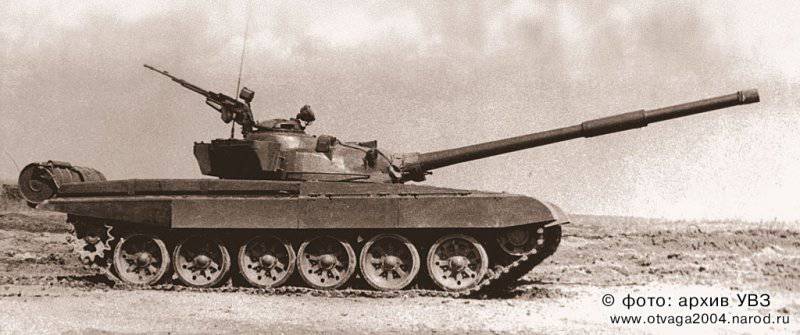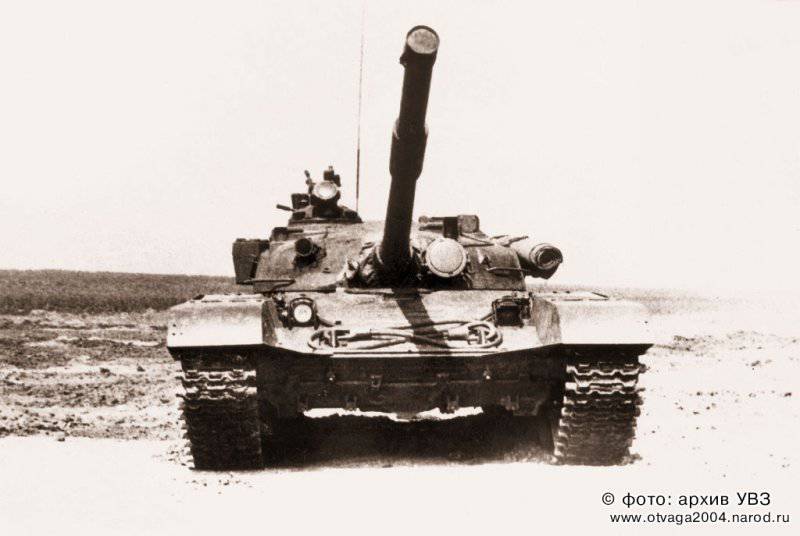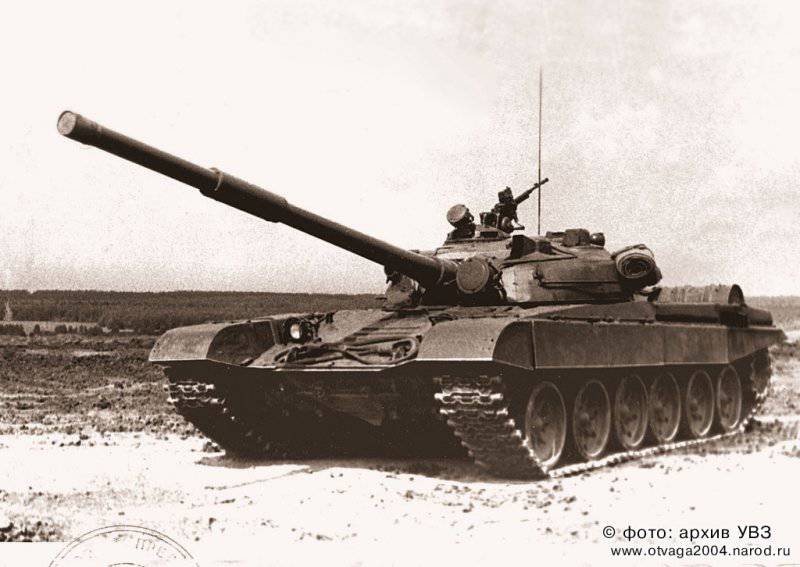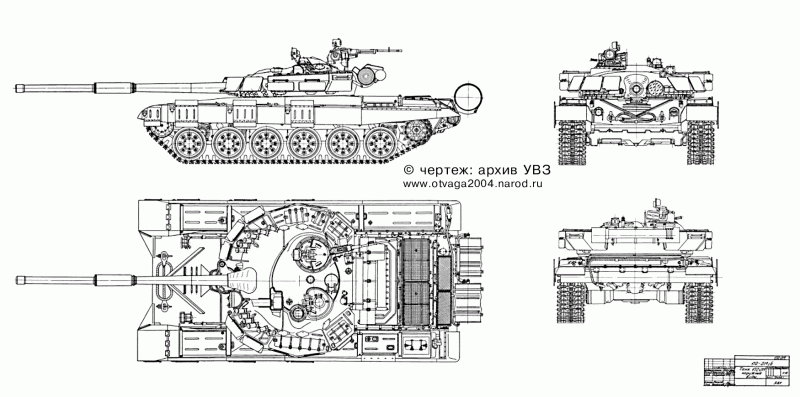Experienced main battle tank "Object 172-2M" (OCD "Buffalo")

In parallel with the work on finalizing and putting into serial production tank T-72 "Ural" (object 172M), Design Bureau of Uralvagonzavod from 1971 to 1975 conducted development work on the theme "Buffalo", aimed at further improving the ob.172M. The first prototype of the machine was built in 1972. It was obtained through the radical conversion of one of the experimental objects 172. In total, seven prototypes of the machine were built in three designs, which received the code “Object 172-2M” and “Object 172M-2M” as part of this work. The second, third and fourth prototypes already had in their basis the design of the 172M. Sample No. 1, together with 15 experimental tanks of the 172M, took part in large-scale tests conducted in the summer-autumn period of 1972 under the leadership of General Yu.M. Potapov. The next three copies were tested in the period 1973-74. in different regions of the country. All samples made by that time from June 1972 to June 1974 performed tests under various climatic and road conditions and traveled at least 15000 km each, while the engines worked from 538 to 664 hours each and remained in good condition.
The main task during the work was a sharp increase in the vehicle performance level. The realization of the ideas led to an increase in weight up to 42 tons in comparison with 41 t of the object 172М. However, the increase in the mass of the machine did not entail a deterioration of the dynamic characteristics. Installation forced to 840 HP the B-46F engine (also later B-67) produced by ChTZ allowed not only to compensate for the increase in mass, but also to increase the specific power to 20 hp per ton of weight. Forcing the engine was carried out by minimal means - processing the design of the supercharger. At the same time, fuel consumption remained almost unchanged. So at the B-67 maximum power mode, 175 g was consumed on 1 hp / h against 172 g in the same mode on B-46 installed on the 172М rev. Coupled with a significantly increased volume of fuel tanks (additional outer ones on the left fender), this made it possible not only to preserve, but also to increase the power reserve. As a result, it reached a record high - 750 km on the highway. The increase in power density also had a positive effect on the increase in the average speed of movement, especially over rough terrain. This also contributed to the introduction of the suspension with an increased dynamic course of the rollers, hydraulic shock absorbers of increased energy intensity, experiments were conducted to change the installation scheme of torsion shafts and balancers in order to more efficiently redistribute the load. The BKP were strengthened, the pressure of the working fluid in the hydraulic control system was increased.
The displacement of the engine bulkhead towards the stern, which was achieved due to some compaction of the logistics procurement system, made it possible to change the arrangement of the BC layouts in the BO, increase the ammunition load from the 39 shots to 45, and make the layout more convenient. More convenient styling allowed for manual loading, aimed fire at speeds up to 2 shots per minute against 1 meters. 44 seconds. on site 172М (according to test data of 15 tanks ob.172М in 1972).
Serious measures were taken in terms of improving armor and structural protection.
On the hull: the resistance of VDD was improved by changing the proportions of the components of the combined protection (the thickness of the rear steel sheet was increased). Installation on top of an additional steel sheet of increased hardness of the wedge-shaped section allowed increasing the physical dimension of protection in the frontal projection and increasing the angle of inclination of the BDT from 68 to 70 degrees, which in turn created more prerequisites for ricochet of modern BPS. As a result, the layout of the VLD package looked as follows: 70-mm steel + 105-mm STB + 40-mm steel at an angle 70 °. Steel platoon screens were installed along the sides of the hull (the feed sections of the screens were made of rubber-metal), covering the board almost all the way down to the level of the supporting rollers down and external fuel tanks to their entire height up. The spaced board protection scheme looked like this: 70-mm board + 16-mm steel screen (BO area) and 70-mm board + 5-mm steel screen (MTO area). In addition, the possibility of installing standard folding screens - "burdocks", covering the side view from the nasal heading corners.
On the tower: the improvement of protection was carried out in two stages. At the first stage, the monolithic solid tower had steel platoon screens in the perspective of +/- 30 hail. The onboard projection of the tower had an external structural protection in the form of a bulk box of spare parts and a steel platoon screen installed in front of it. Aft projections of the tower were also shielded with ziPa boxes and external weights (pipe OPVT, rolling of a canvas cover, wind shield, a case under the gun bannik). At the second stage it was planned to install a cast tower with a combined filler. In general, the frontal projection of the 172-2М object provided protection against a 125-mm sub-caliber projectile with a carbide-tungsten tip, which has a speed at the time of the meeting with the target 1600 m / s. The armor of the usual T-72 saved only from the 115-mm projectile at a speed of 1400 m / s. Protection against cumulative weapons in the frontal part of the hull and turret increased by about 10-15% and was equivalent to 500 ... 520 mm of medium-hardness armor steel. In the standard T-72 (tower with "corundum balls" - 1975g.), This figure was only 450 mm.
All machines were equipped with anti-aircraft machine gun. The first model had a closed-type machine-gun from the T-64 tank, the rest were equipped with the Z-72 open-air anti-aircraft gun standard for the T-72.
In the middle of 1974, the testing of an even more powerful version of the tank “Object 172М-2М” began, with improved instruments for monitoring the battlefield and a new aiming complex. The 6 and 7 copies of the machine were fitted with a laser rangefinder TPD-K1, a Buran-PA night sight, new commander and gunner observation devices, a Jasmine-2 gun stabilizer with an electric drive in the horizontal plane (the usual stabilizer 2E28M had only a hydraulic drive). As soon as it was ready, the commander's observation device “Agat-T” was to be installed on the machine. In addition, the improved 125-mm gun 2А46М (D-81ТМ) was distinguished by higher accuracy due to the reduced thickness of the barrel and the installation of a heat shield on it. The measures taken allowed to increase the number of hits when firing on the go at 1600 ... 1800 m ranges on tank-type targets to 80-100% (according to the results of 15 tanks testing in 172М in 1972, the number of hits when shooting on the move was 50,4%) . The deviation of the mean point of impact on the height at a distance of 1 km in the rain conditions reduced the thermal shield to 15 cm - against 3,6 m without it. Additional devices have increased the static angle of view of the commander from 144 to 288 degrees, the gunner - from 60 to 150 degrees, respectively. In order to tactical camouflage, in addition to the TDA, the 902A “Cloud” smoke curtain system was installed on the machine.
In parallel, in 1973-75, in the Tagil design bureau, a variant of a tank with a 130A2 rifled XNUM-mm cannon (LP-50) developed by the design bureau of the Motovilikha plants (Perm, Gl. Designer Kalachnikov U.N. and its smooth pattern had been drawn. under the 36-mm guided missile (a joint proposal of the Scientific Research Institute-36 (last NIMI) and the Nudelman Design Bureau).
However, the engines on tanks №5-7 did not work very reliably. Unlike the first four, they worked an average of just 200 with a little hours. The main problems were related to the release of oil from the oil separator and loss of coolant. In the 1975 year, the CTZ designers of the B-67 diesel engine (previously called the B-46F) were urgently modified, the defects found were eliminated. In 1976, it was planned to conduct military tests of ten tanks “Object 172-2М” and “Object 172М-2М”. In the course of four years of intensive operation, the 172-2М and about. 172М-2М in different road and climate conditions nodes, mechanisms and systems of tanks showed high reliability and durability, ensuring testing and movement of the tank without speed limitation during the test, the ambient temperature from -38 ° С to + 40 ° WITH.
Tests have shown that the B-46F / B-67 diesel resource is more than 500 hours; reinforced gearboxes, guitars, drives to the fan, starter-generator and compressor, cooling fan, supporting rollers, guide and driving wheels, torsion shafts, hydraulic shock absorbers - 15 km of km; tracked belts - 6,5 km of summer and 10 km of frozen ground. The coefficient of unification with respect to the “172M Object” was about 88%, so the transition to the production of a more powerful model did not require re-equipment of production workshops. In the next two to three years, one could expect the “Object 172М-2М” tank to be adopted - an improved version of the T-72.
However, this did not happen for a variety of reasons of more administrative and political nature. However, something from the “172М-2М” object already in 1975 was transferred to production vehicles: for example, reinforced gearboxes, additional viewing devices. Everything else was not claimed, and instead of starting production of the “172-2M Object”, the Decree of the Central Committee of the CPSU and the USSR Council of Ministers No. 1043-361 from December 16 of 1976 of the year was required to work on the creation of a “T-72 tank with enhanced characteristics”. The latter either repeated the already existing TTX “Object 172М-2М” (840 hp engine, laser rangefinder sight, 44 rounds of ammunition), or even inferior to it. In particular, it was proposed to leave the stabilizer of the 2-28M gun, the TPS-3-49 night sight.
As a curiosity, we should mention two common legends related to the work on the 172-2М object. The first legend says that “Buffalo” (the so-called prototype was unofficially called prototype machines) was the prototype of the T-72 “Ural”, which is fundamentally wrong, if only because the 172-2M was created exactly as an object upgrade 172M, i.e. T-72 "Ural". According to the second legend, the name “Buffalo” was proposed to be called in the series the T-72 tank (rev.172М). The proposal allegedly came from the chief designer Venediktov V.N. to the leadership of the country, but was rejected because of its "animal" origin, which caused morally unpleasant associations with the names of foreign tanks (implied, apparently German cars), and was replaced by neutral and patriotic - "Ural". However, this is not true, since it is again implied that the "Buffalo" was the prototype of the "Ural". The likely reason for the emergence of both legends is that chronologically, work on the 172-2М object was carried out simultaneously with work on 172M and accordingly superimposed on each other in the memory of veterans. It should also be added that in conversations, memories, and sometimes in literature, exclusively associative, sometimes “Buffalo” is mistakenly called “Bison” - they confuse little animals.
Currently, the first prototype of the “Object 172-2М” is located in the storerooms of the museum of armored vehicles in Kubinka, which is actually rotting at the dump. On persistent requests to transfer it to the Uralvagonzavod museum, GABTU responds with categorical refusals.
MODIFICATIONS
• Object 172-2М first prototype - made by converting a prototype about .172, in turn obtained by reworking the tank T-64А
• Object 172-2М second, third and fourth prototypes - made on the basis of the design ob.172М
• Object 172-2М fifth prototype - made on the basis of the design ob.172М with the installation of the engine B-67
• The sixth and seventh prototypes 172М-2М are made on the basis of the design ob.172-2М. Significantly improved OMS, weapons, installed system 902A, engine B-67
• The 172-3М object is a project based on the 172-2М construction with the installation of a 130-2 rifled 50-mm gun (LP-36).




Information